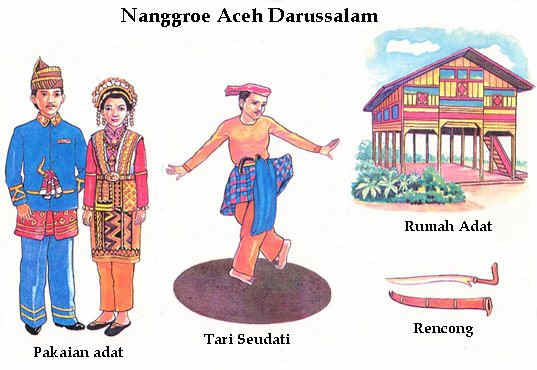Aceh Culture. Acehnese who had once been called by the name of Aceh (1959-2001) and Nanggroe Aceh Darussalam (2001-2009) is a province in Indonesia and is the westernmost province in Indonesia. Aceh has the autonomy to set its own, unlike most other provinces in Indonesia, for historical reasons. This area is bordered by the Bay of Bengal in the north, the Indian Ocean to the west, the Strait of Malacca in the east, and North Sumatra in southeast and south.
The capital of Aceh is Banda Aceh. Its port is Malahayati-Krueng Raya, Ulee Lheue, Sabang, Lhokseumawe and Langsa. Aceh is the region worst hit by the earthquake and tsunami of 26 December 2004. Some places on the coast disappear altogether. The hardest is Banda Aceh, Aceh Besar, Aceh Jaya, Aceh Barat, Singkil and Simeuleu.
Aceh has a wealth of natural resources such as petroleum and natural gas. Natural Resources is located in North Aceh and East Aceh. Aceh is also famous for its forest resources, which is located along the Bukit Barisan range, from Kutacane, Aceh Tenggara, until Seulawah, Aceh Besar. A national park, namely Leuseur Mountain National Park (TNGL) is also available diAceh Southeast.
Aceh has a language of cultural roots of Khmer language family Monk proto-Malay language with other languages such as regional distribution of the southern part of language use Aneuk Jame while the Central, Southeast, East and southeast Gayo.Untuk language use the language beyond the eastern Alas further east again use language such Tamiang.Dengan Klut ethnic groups who are using the language of the southern part Klut while in Simeulue Simeulue language but each local language can also be divided into dialects. Language of Aceh, for example, is talking with a few differences in Aceh Besar, Pidie and North Aceh. Similarly, in language there Gayo Gayo Lut, Gayo Series, and the dialect of Gayo Lues and other ethnic groups. Singkil located southeast (Tanoh Alas) use the language Singkil.
Aceh early in anthropology sources mentioned that the origin comes from the tribe Mantir Aceh (or in the Acehnese language: Mantee), which has linkages with Charm in Malacca which is part of the Mon Khmer (Khmer Monk). According to other sources of historical narrative mentioned that especially the people of Aceh Besar where his residence in the village which is also called the village Seumileuk Rumoh Two Blaih (village Rumoh 12), is located on top of the village Seulimeum Jantho with Tangse. Seumileuk meaning broad plains and Mantir then spread throughout the valley of Aceh three terms and then moved around to other places.
Aceh is one of the earliest regions to receive the Islamic religion. And most of the people of Aceh are Muslim. Therefore the province is known as the "Veranda of Mecca", meaning "gate" the closest between Indonesia and the place from where the religion originated. Nevertheless the original culture of Aceh do not go away, otherwise some elements of local culture and blend influenced by Islamic culture. Thus culture is the result of acculturation style Islamic culture gave birth to a typical-Aceh. In these cultures, there are still remnants of animistic belief and dynamism.
One of the interesting cirri of Acehnese dances go round dance performed in groups. Saman dance is one of the typical dances of Aceh that has been known since the first of which each dancer cooperate gerakanya preformance.
Aceh has a variety of typical foods. Among others timphan, curry duck, curry goat is delicious, curry Pliek meuseukat U and rare. In addition, chips melinjo origin of the famous tasty Pidie district, Sabang lunkhead made with different flavors, durian glutinous (boh drien Ngon leukat bu), and sweet cakes from Peukan Bada, Aceh Besar could also be a mainstay for Aceh.
Clothes used customary law women or men, have the same pattern although the form itself. What distinguishes it is the attribute, be it formal or traditional clothes that are used daily.
For the traditional clothes worn men's black colored. The black color Acehbermakna greatness indigenous communities. So if a person wearing a black shirt and pants means the person is in view of the Acehnese people are wearing clothes his greatness. This is different than people in other areas, when wearing black clothes, it could mean they're in mourning because of something unfortunate that happened. But not for the people of Aceh. In Aceh the groom must make use of black clothing and should not wear any other color. Likewise for traditional ceremonies required to use pakian black.


